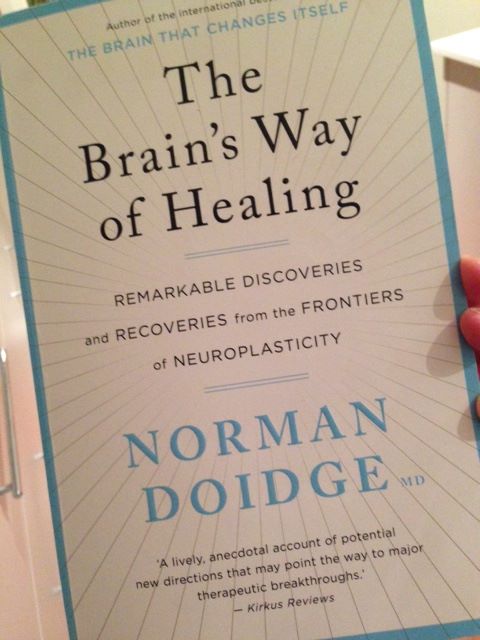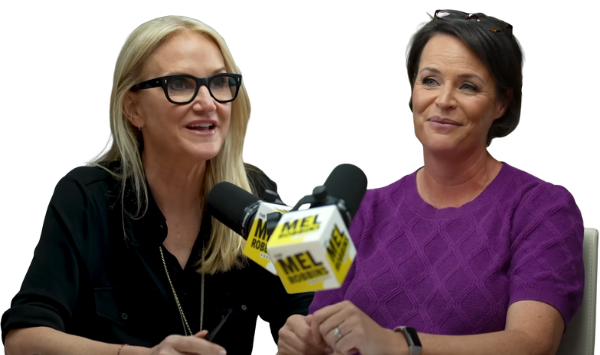
As I mentioned a couple of weeks ago, I’ve been reading Norman Doidge’s latest book ‘The Brain’s Way of Healing: Remarkable Discoveries and Recoveries from the Frontiers of Neuroplasticity.‘
Doidge’s first book, The Brain That Change’s Itself, has become one of the most popular science books around describing the phenomenon of neuroplasticity, and was largely responsible for bring the topic into public consciousness. I’ve lost count of the number of times people have told me they’ve read it and it was their main introduction to the world of neuroscience.
Doidge’s new book continues with the original themes such as ‘the mind changes the brain,’ and ‘neurons that fire together wire together, and ‘the brain has capacity to heal’. As Doidge explains,
The Brain’s Way of Healing extends the reach of neuroplastic treatments, to provide new hope for people who suffer from many kinds of chronic pain, stroke, Parkinson’s disease, attention deficit disorder, autism, multiple sclerosis, traumatic brain injury, learning disorders, sensory processing disorders, balance problems and provides information on how to reduce the risk of dementia by 60%.
A few of the stories include:
- A doctor who conquered chronic pain by flooding his brain with non-pain stimuli and visualising brain maps and imagining the areas devoted to pain shrinking.
- An elderly Parkinson’s patient who reversed his worst symptoms with an intensive fast walking program and a special kind of concentration and was able to stop his medication. He had to keep up the exercise to maintain the improvement, which suggests to me that the brain had not re-wired itself very well.
- A man blind from uveitis who stopped all his medications and learned to see again by visualising (imagining) a blue-black field and doing various exercises.
- A man with MS who used a Portable Neuromodulation Stimulator (PoNS) to stimulate the tongue; it restored his ability to sing and to walk without a cane.
- A dyslexic boy who listened to Mozart and to recordings of his mother’s voice and is now at the top of his class.
The book has had a fpolarising reviews.
Some are glowing:
“The power of positive thinking finally gains scientific credibility. Mind-bending, miracle-making, reality-busting stuff…with implications for all human beings, not to mention human culture, human learning and human history.” -The New York Times
“Brilliant…Doidge has identified a tidal shift in basic science…The implications are monumental.” -The London Times
Others are more circumspect, such as this review by Harriet Hall on the Science-Based Medicine blog:
The idea that you can re-wire your own brain is a double-edged sword. It offers hope and empowerment, the sense that you can control your own destiny. But it lends itself to blaming the victim if the treatment is unsuccessful, suggesting the patient didn’t try hard enough. And it comes perilously close to New Age mind-over-matter create-your-own reality woo-woo.
One scathing review concludes,
Hope is a tricky commodity however, and while some of us may find it heartening, for others it could be another turn of the fatal screw. The neuroplastic revolution is part of a contemporary stampede towards the moralisation of medicine: patients are encouraged to blame themselves for their sufferings, and to think that their chances of recovery depend not on random tricks of fate, or the luck or good judgment of their doctors, but on their own willpower and moral fibre. Sick people need to be cared for, but they also have a right to be left in peace.
At the time of writing this blog post I’m still dipping into the book most evenings. I’ve been captivated by the storytelling and feel the same awe about the brain and the possibilities of neuroscience as I did when I read some of Oliver Sacks’ early work (which was HUGELY influential on me taking up neuroscience as a career). But I wonder if Doidge isn’t overreaching a little with the science at times (mostly in the chapter on cold lasers).
Personally, I couldn’t be more grateful to Doidge for giving one of my neuro-passions such a public platform. Before his first book came out, saying “My PhD looked at neuroplasticity in the developing brain,” was met with blank stares. I sometimes think Doidge’s book was partly responsible for people now falling over themselves to tell me how fascinating they find my thesis.
Because I LIVE for these debates, I’m choosing The Brain’s Way of Healing for the April Walking Book Club. As I’m no longer posting specific Qs about the Walking Book Club choices – I’ll try to garner more discussion and debate over on my FaceBook page – some come join in.
And if you need a reminder of the philosophy behind the Walking Book Club – click over to this page to learn a little more.
Share the love
[Sassy_Social_Share]
5 Comments
Leave a Comment
About Dr Sarah
Neuroscientist, Author, Speaker, Director of The Neuroscience Academy suite of professional training programs.
Latest Posts
Free 10 day micro-training in neuroscience

Learn one neuroscience concept a day!
10 simple, bite-sized lessons in brain health, delivered daily to your inbox


Thanks for your review Sarah and flagging that this book is out. I loved his first book and will be getting this new one soon – fascinating area!
Well I probably owe you – the number of articles I’ve ended up reading that you’ve tipped me off on Tim!!!
My husband was diagnosed of Parkinsons disease 2 years ago, when he was 59. He had a stooped posture, tremors, right arm does not move and also a pulsating feeling in his body. He was placed on Senemet for 8 months and then Siferol was introduced and replaced the Senemet, during this time span he was also diagnosed with dementia. He started having hallucinations, lost touch with reality. Suspecting it was the medication I took him off the Siferol (with the doctor’s knowledge) him on PD natural herbal formula we ordered from TREE OF LIFE HEALTH CLINIC, his symptoms totally declined over a 3 weeks use of the TREE OF LIFE HEALTH Parkinson’s disease natural herbal formula. He is now almost 61 and doing very well, the disease is totally reversed! (w w w. treeoflifeherbalclinic .com)
After bouts with many neurologists I stopped all the Parkinson’s disease medicines prescribed due to severe side effects, and decided to go on natural herbal approach. My primary care provider introduced me to Kykuyu Health Clinic and i immediately started on their Parkinson’s disease herbal formula treatment, this herbal treatment has made a tremendous difference for me. My symptoms including shaking, muscle weakness, fatigue, mood swings, numbness, double vision and urinary retention all disappeared after the 4 months treatment! Their website is w w w. kykuyuhealthclinic. c o m. Its just amazing!
Why keep making humans suffer greatly just to get profits annually for medications that don’t work. I’m glad that herbal remedies are gaining so much awareness and many people are getting off medications and activating their entire body system with natural herbal remedies and they have become holistically healed totally, It’s also crucial to learn as much as you can about your diagnosis. Seek options: ( worldrehabilitateclinic. com ).